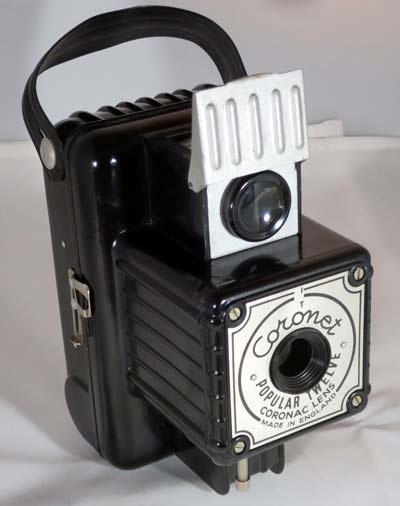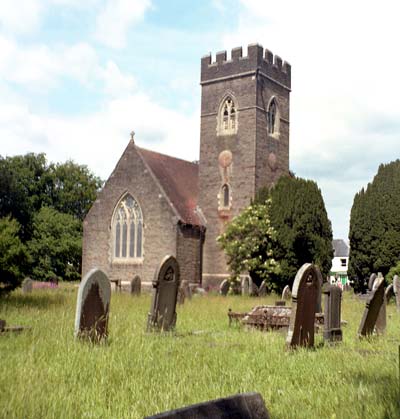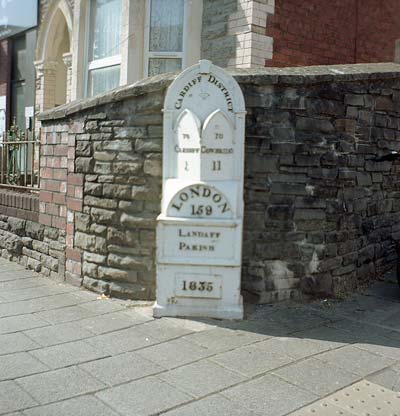Coronet Popular Twelve
Specification

| Manufacturer | : | Coronet |
|---|---|---|
| Produced | : | 1952 |
| Classification | : | Medium Format |
| Body Type | : | Solid Body |
| Construction | : | Bakelite |
| Film Type | : | 120/620 |
| Film Width | : | 62mm |
| Image Size | : | 6 x 6 cm |
| No. of Images | : | 12 |
| Lens Type | : | Meniscus |
| Focal Length | : | 75mm |
| Focus Type | : | fixed |
| Focal Range | : | 8ft - Inf. |
| Aperture Type | : | Fixed |
| Apertures | : | f/16 |
| Shutter Type | : | Fixed Speed Leaf |
| Shutter Speeds | : | I*(1/40s) |
| Size (w x h x d) | : | 90 x 125 x 100 mm |
| Weight | : | 300g |
| * Measured on this camera | ||
Art Deco Credentials
![]()
![]()
![]()
Noteworthy: Worth giving special attention
- Produced after the main Art Deco period.
- Curvilinear box body.
- Bakelite body with horizontal linear ribbing.
- Bakelite back with vertical linear ribbing.
- Molded ribbed table stand.
- Ribbing to viewfinder cover.
Description
The Coronet Popular Twelve is a quirky viewfinder roll-film camera made of Bakelite by Coronet in England. It is similar to the Coronet Dynamic 12 Camera. The use of Bakelite allowed the designers' imagination to run wild, resulting in a most individual camera in which the curvilinear nature of the film compartment is juxtaposed to the box nature of the lens compartment and viewfinder. The camera can use both 120 and 620 film rolls and produces twelve 6 x 6 cm exposures. It has a large brilliant viewfinder, ever-set leaf shutter and a silent winding key. The viewfinder has a ribbed metal cover. Several versions of the camera exist. Some have a larger curved viewfinder body.
This version of the camera only has instantaneous shutter mode even though there is annotation on the front plate which shows both I and T. Other cameras in the series have the T/I switch and flash contacts. The shutter release is below the lens box and it has to be pushed up to trigger it. This is both inconvenient and uncomfortable. Film advance is by a knob on the side and exposures are counted using a red window which has a swinging metal cover. It does not have a tripod mount.
How to Use
This camera takes 120 film which is easily available. It supports instant(I) mode only with a speed of about 1/40 sec. It has a single aperture settings of f/16. With a shutter speed of only 1/40 sec, make sure you brace the camera against your body or something solid and press the shutter smoothly to avoid camera shake.
If you don't want to bother with an exposure meter, follow the guide shown. It is based on the 'Sunny 16' rule. Film is so forgiving and will produce acceptable results even when over-exposed by 2 or 3 stops or under-exposed by 1 stop.
The table shown assumes the shutter speed is about 1/40s.
The table also assumes that the sun is at least 30 degrees above the horizon - that's 10am - 5pm on a summers day in the UK.
Remember that the exposure guide in the manual may not be helpful as it is based on the use of old film with a low ISO value.
So, on a nice sunny day, it's simplicity itself. Just load film and snap away.
Using ISO 100/125 film - shutter speed 1/40s
| Weather Conditions | Shadow Detail | Aperture | Exposure |
|---|---|---|---|
 Sunny SunnySnow/Sand | Dark with sharp edges | f/16 | +2 Stop Overexposed Acceptable |
 Sunny Sunny | Distinct | f/16 | +1 Stop Overexposed Acceptable |
 Slight Overcast Slight Overcast | Soft around edges | f/16 | Good |
 Overcast Overcast | Barely visible | f/16 | -1 Stop Underexposed Acceptable |
 Heavy Overcast Heavy Overcast | None | f/16 | -2 Stops Underexposed Not Acceptable |
 Open Shade Open Shade/Sunset | None | f/16 | -3 Stops Underexposed Not Acceptable |
Photographs taken with this Camera
Kodak Portra 160, 120 film. Developed in Tetenal



